La collaboration est un processus qui rassemble les gens et les aide à s'organiser. En outre, elle permet aux équipes de se répartir les tâches et d'accomplir de formidables réalisations.
Toutefois, collaborer efficacement n'est pas un don, mais une compétence, ou un ensemble de compétences, que chacun peut développer et améliorer.
En développant de bonnes compétences de collaboration au sein d'une équipe, l'efficacité globale est stimulée, les résultats pertinents sont améliorés et les objectifs communs sont atteints beaucoup plus facilement.
Dans cet article, nous examinerons les points suivants :
- La définition des compétences de collaboration,
- Les compétences les plus importantes pour une collaboration réussie,
- Les exemples de bonnes compétences de la collaboration, et
- Les moyens d'améliorer les compétences de collaboration des individus et des équipes.
C'est parti !
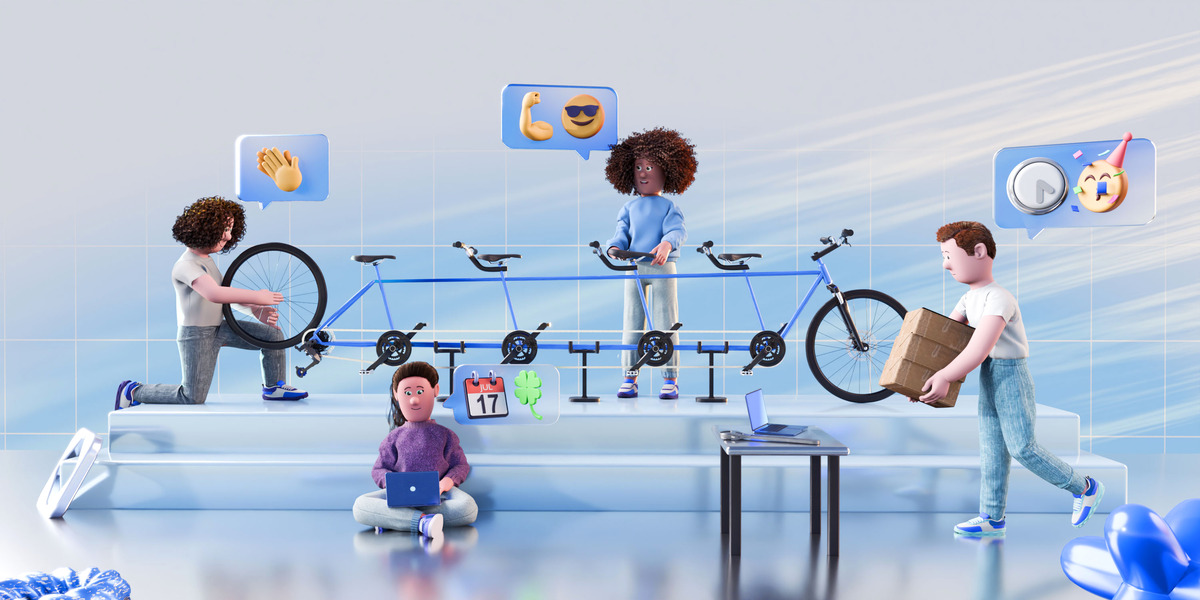
Quelles sont les compétences en matière de collaboration ?
Les compétences en matière de collaboration incluent de multiples comportements, qualités personnelles et états d'esprit qui aident toute équipe à fonctionner et à être plus performante, dans l'intérêt de toutes les parties concernées et des objectifs à court et à long terme de l'entreprise.
En prenant en compte les différents aspects de la collaboration, nous pouvons parvenir à une définition complète des compétences en matière de collaboration :
Les compétences de collaboration sont l'agrégation des compétences identifiées comme pertinentes pour le processus de collaboration, comme :
- La communication de l'équipe,
- L'intelligence émotionnelle, et
- Le savoir-faire opérationnel.
Donc, nous pouvons observer un ensemble de compétences de collaboration qui nous permet de bien travailler avec les autres, et analyser les comportements qui conduisent à des résultats positifs liés à une collaboration efficace.
Exemples de meilleures compétences de collaboration sur le lieu de travail
Bien que conscients de la nature cruciale de la collaboration, beaucoup de gens ne réalisent pas encore quelles compétences ils doivent développer pour prétendre au titre de bon collaborateur et de joueur d'équipe.
Tout bien considéré, les principales compétences de collaboration sur le lieu de travail que chacun devrait travailler sont les suivantes :
- Communication,
- Ouverture d'esprit,
- Compromis,
- Organisation et délégation,
- Réflexion à long terme,
- Confiance,
- Positivité, et
- Résolution des conflits.
Nous allons donc analyser des exemples de collaboration réussie et voir comment ces compétences façonnent un environnement de travail solide.
Compétence de collaboration n°1 : Communication
La communication dans un groupe est essentielle pour la réussite de toute équipe. Elle peut faciliter non seulement la collaboration, mais aussi la prise de décision. C'est également un moyen efficace de gérer et de résoudre les conflits au sein de l'équipe.
Mais il n'est pas facile de communiquer efficacement au sein d'un groupe. Parfois, les personnes qui sont d'excellents communicateurs en tête-à-tête ne parviennent pas à communiquer leurs idées au sein d'un groupe.
Pour s'adapter à tous ses membres et à leurs divers styles de communication, il est essentiel que l'équipe fasse de la place à tous les types de communication et canaux de communication.
Voici un bon exemple.
L'équipe doit faire un brainstorming sur le format de la nouvelle proposition. Bien que certains membres de l'équipe aient commencé à partager leurs idées par message, l'un d'entre eux a proposé de faire un appel, ce que les autres ont accepté bien sûr. En choisissant un canal de communication plus adapté à leur activité (le brainstorming), ils ont rendu leur communication plus efficace, car il est devenu plus facile de partager des idées et des opinions.
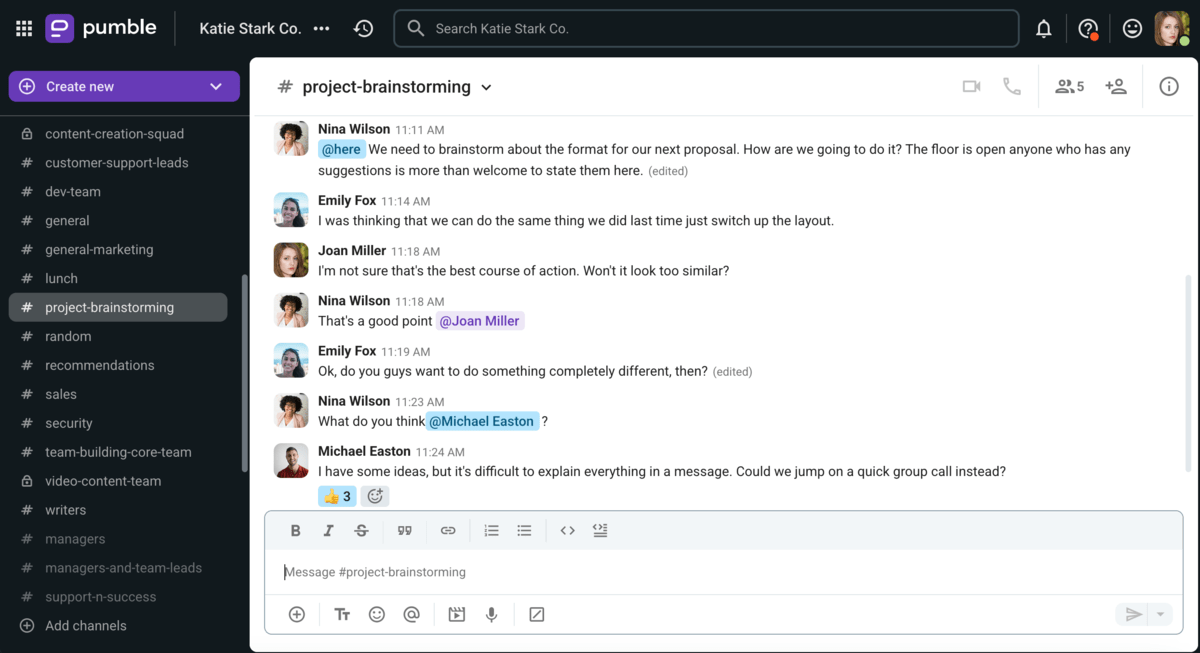
J'organise mon équipe avec Pumble
🎓 Pumble Pro Tip
Améliorer la communication au niveau individuel ainsi qu'au niveau du groupe est vital pour la collaboration. Si vous voulez en savoir plus sur la façon dont vous pourriez améliorer l'efficacité de votre communication de groupe, lisez l'article suivant :
Compétence de collaboration n°2 : Ouverture d'esprit
Être ouvert aux nouvelles idées et respecter le fait que tout le monde ne pense pas comme nous est la base d'une bonne collaboration. Les personnes ouvertes d'esprit :
- Acceptent que leurs idées soient questionnées, améliorées ou mises à l'épreuve,
- Peuvent admettre qu'elles ont tort et changer de point de vue,
- Sont humbles quant à leurs connaissances, mais n'hésitent pas à les partager,
- Croient que la voix et l'opinion de chacun valent la peine d'être entendues, et
- Ont un sens aigu de l'empathie.
Mais comment peut-on appliquer cela à la collaboration d'équipe ?
Bon, les équipes qui collaborent ont rarement des membres qui ont tous les mêmes compétences et la même expertise. Au contraire, la plupart des équipes sont transversales — c'est-à-dire avec des membres de différentes parties de l'entreprise, qui possèdent des compétences complémentaires (mais différentes) et qui travaillent ensemble à la réalisation d'un objectif commun.
Lorsque l'on travaille dans ce type d'équipe, il est essentiel de garder à l'esprit que chaque membre peut avoir un point de vue différent sur des problèmes ou des sujets spécifiques.
L'ouverture à ces points de vue et aux nouvelles idées favorise un environnement productif et collaboratif.
Compétence de collaboration n°3 : Compromis et adaptabilité
De toutes les compétences de collaboration, le compromis et l'adaptabilité sont peut-être les plus difficiles à maîtriser.
Quand nous travaillons en équipe, nous nous attendons à ce que tout se passe sans problème. La réalité de la plupart des projets est cependant que quelque chose va mal se passer : les dates butoirs vont être reportées, les priorités vont changer et les idées vont être abandonnées.
La façon dont nous réagissons et nous comportons dans de telles situations est le reflet de notre capacité d'adaptation.
La capacité à penser aux besoins de son équipe et à travailler avec les autres pour trouver un juste milieu (ou un compromis) est essentielle à la réussite de toute équipe. Lorsque les membres d'une équipe ont des idées ou des points de vue contradictoires, leur aptitude à trouver un juste milieu détermine la probabilité de leur réussite globale.
Donner la priorité à la recherche d'une solution efficace plutôt que d'avoir raison est extrêmement important pour la collaboration d'une équipe, car cela peut aider les membres de l'équipe :
- Travailler sans conflit,
- Résoudre plus rapidement les conflits et les problèmes,
- Trouver des solutions meilleures et plus innovantes, et
- S'entendre mieux.
Par exemple, un créateur vidéo et un spécialiste des médias sociaux peuvent ne pas être d'accord sur le moment le plus opportun pour publier un nouveau produit vidéo. Cependant, ils peuvent tous deux trouver un compromis et une solution acceptable qui répondent aux besoins des deux parties, comme dans l'exemple ci-dessous.
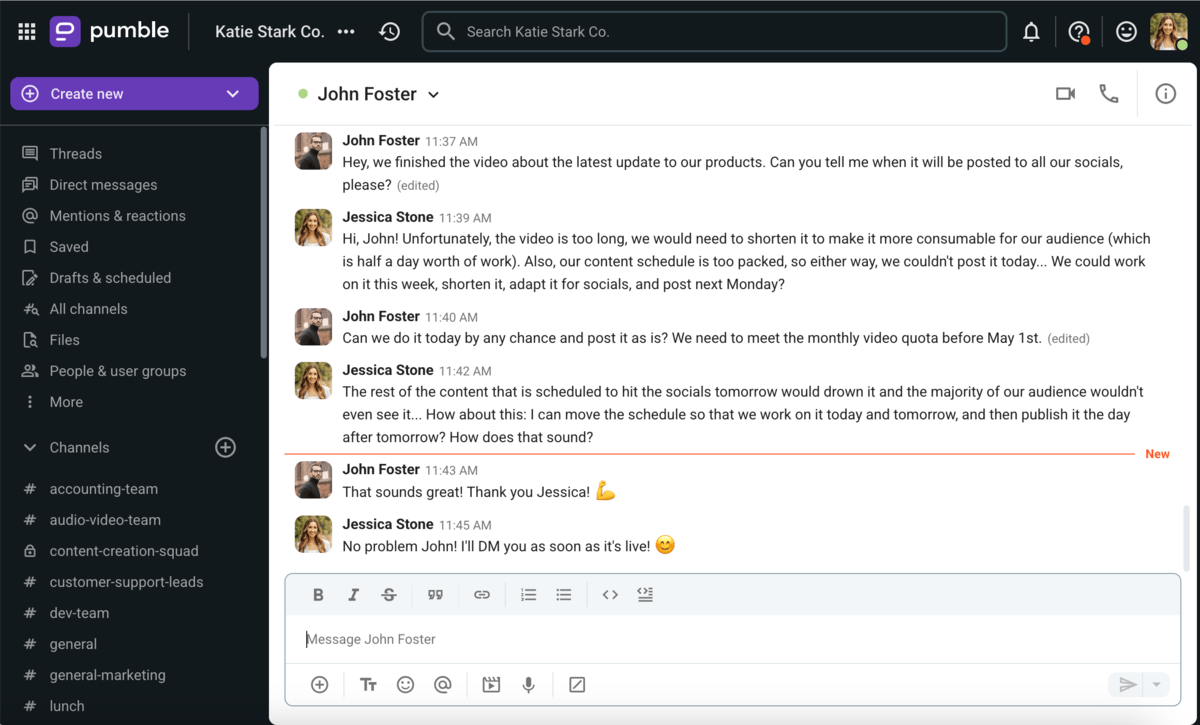
Rationaliser la communication avec Pumble
Compétence de collaboration n°4 : Organisation et délégation
L'organisation de la charge de travail et la délégation des tâches sont essentielles à la réussite. Si certains membres de l'équipe sont surchargés et que d'autres n'ont aucune tâche à accomplir, le travail ne sera pas fait (ou mal fait). De plus, il n'y aura pas non plus de collaboration entre les membres.
Selon Gretchen Anderson, auteur du livre Mastering Collaboration: Make Working Together Less Painful and More Productive, il est important de donner un rôle à chaque membre de l'équipe. Elle affirme que l'attribution d'un rôle à chacun rend l'équipe plus efficace, car cela :
- Facilite la mise en œuvre de nouvelles idées,
- Aide les gens à canaliser leur énergie,
- Aide à déterminer et à maintenir les limites,
- Motive tous les participants,
- Réduit les tensions inutiles liées à la délégation des tâches.
Compétence de collaboration n°5 : Réflexion à long terme
Être capable de penser à long terme et d'envisager son objectif, mais aussi tous les moyens potentiels que l'équipe pourrait prendre pour atteindre cet objectif, c'est faire preuve de réflexion à long terme ou de prévoyance.
Chaque projet a une vision commune ou un résultat idéal. Les bons collaborateurs s'investissent dans ce résultat et sont conscients de l'étendue du projet. Ils savent quel est le rôle de chacun et comment et pourquoi ce rôle contribuera à l'objectif final.
Voici un bon exemple de la manière dont la réflexion à long terme peut améliorer la collaboration d'une équipe, sur Pumble, une application de communication pour les entreprises.
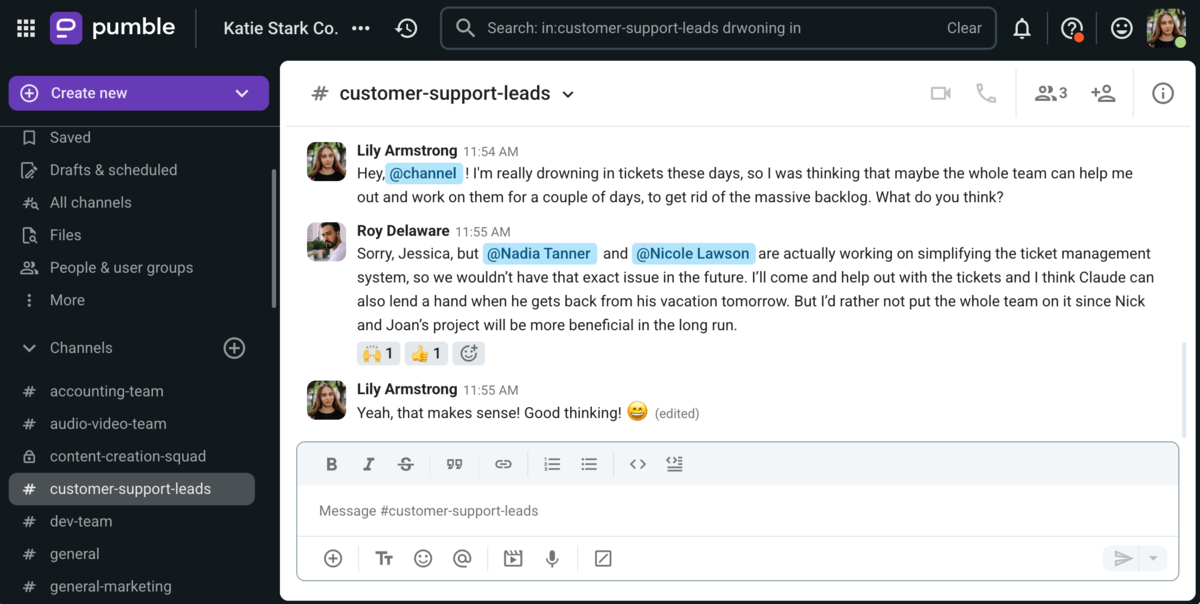
Optimiser les processus d'équipe avec Pumble
Compétence de collaboration n°6 : Confiance
La confiance est la conviction que nos collègues possèdent toutes les compétences et les connaissances nécessaires pour prendre des décisions ou exécuter des tâches. La confiance facilite la collaboration, mais elle n'est pas une condition préalable au succès.
Les équipes dont les membres se font confiance sont plus innovantes, car la confiance permet de prendre des décisions et de résoudre des problèmes plus rapidement. Cependant, il faut beaucoup de temps pour prendre confiance dans un groupe, même s'il est petit.
Ainsi, contrairement à une opinion répandue, la confiance n'est pas une nécessité pour réussir (mais elle est certainement utile).
La confiance aide les équipes à surmonter les obstacles à la collaboration, c'est pourquoi elle est l'une des compétences clés de la collaboration.
Compétence de collaboration n°7 : Positivité
Lorsque nous sommes motivés et positifs, nous pouvons aider les autres en améliorant leur humeur.
Promouvoir la positivité dans une équipe stimule l'efficacité. En outre, une attitude positive peut contribuer à renforcer toutes les autres compétences de collaboration. Lorsque nous sommes positifs, nous :
- Pouvons établir plus facilement la confiance dans une équipe,
- Nous sommes plus ouverts d'esprit,
- Nous communiquons mieux, et
- Nous sommes plus disposés à faire des compromis.
Compétence de collaboration n°8 : Résolution des conflits
Les conflits sont un élément inévitable du travail d'équipe, mais pour une collaboration productive, il est important de savoir comment les gens les gèrent.
La capacité à résoudre efficacement les conflits comprend plusieurs compétences, telles que :
- Contrôler ses émotions,
- Gérer les désaccords,
- Trouver une solution qui réponde aux besoins des deux parties.
Ces compétences aident les gens à reconnaître les différentes perspectives, ce qui les aide à trouver une solution acceptable pour les deux parties.
Comment améliorer les compétences dans la collaboration ?
Si vous vous demandez comment développer et améliorer vos compétences en matière de collaboration, voici les méthodes les plus efficaces qui vous aideront à devenir un excellent collaborateur :
- Créez une sécurité psychologique pour votre équipe,
- Communiquez clairement vos intentions et vos pensées et fixez des objectifs précis et clairs,
- Écoutez activement les autres et reconnaissez leur rôle dans l'équipe,
- Faites des compromis et évitez de rejeter la faute sur autrui,
- Formulez des critiques constructives à l'égard de vos collègues, acceptez le feedback et célébrez les succès de votre équipe, et
- Évaluez les compétences en matière de communication dans votre lieu de travail.
Allez, on apprend plus sur ces compétences.
Astuce n°1 : Créez la sécurité psychologique
La sécurité psychologique, ou le fait de savoir que nous sommes libres d'exprimer nos opinions et même de faire des erreurs sans avoir peur des répercussions, n'est pas seulement fragile, mais aussi vitale pour le succès de toute équipe.
Selon la recherche de Harvard Business Review, le succès d'équipes diversifiées dépend en grande partie de la sécurité psychologique.
Pour créer un environnement de travail psychologiquement sûr, les leaders doivent : Pour créer un envirenmment
- Inclure les gens dans le processus de décision,
- Valoriser leurs points de vue,
- Leur demander un feedback et une opinion, et
- Les encourager à apprendre de leurs erreurs.
Pour cela, il est essentiel que les leaders donnent l'exemple et modèlent les comportements qu'ils souhaitent voir dans leurs équipes.
Astuce n°2 : Communiquez vos intentions et fixez des objectifs clairs et précis
Comme la collaboration est très complexe, il est facile pour les membres d'une équipe collaboratrice de se perdre dans leurs propres tâches et missions. C'est pourquoi il est essentiel que chaque membre communique de manière transparente.
Mais cela ne suffit pas. Pour favoriser la collaboration, chaque membre doit communiquer ses intentions en détail.
Par exemple, il est toujours bon de communiquer à ses collègues la tâche que l'on prend en charge, ce que l'on compte en faire et quand on prévoit de la terminer.
De cette façon, vous évitez tout risque de chevauchement des tâches avec les autres membres et réduisez les risques de malentendus.
Par exemple, dans la capture d'écran de l'espace de travail de Pumble ci-dessous, on peut voir que les membres de l'équipe audiovisuelle organisent leur charge de travail en tenant compte des délais et des priorités.
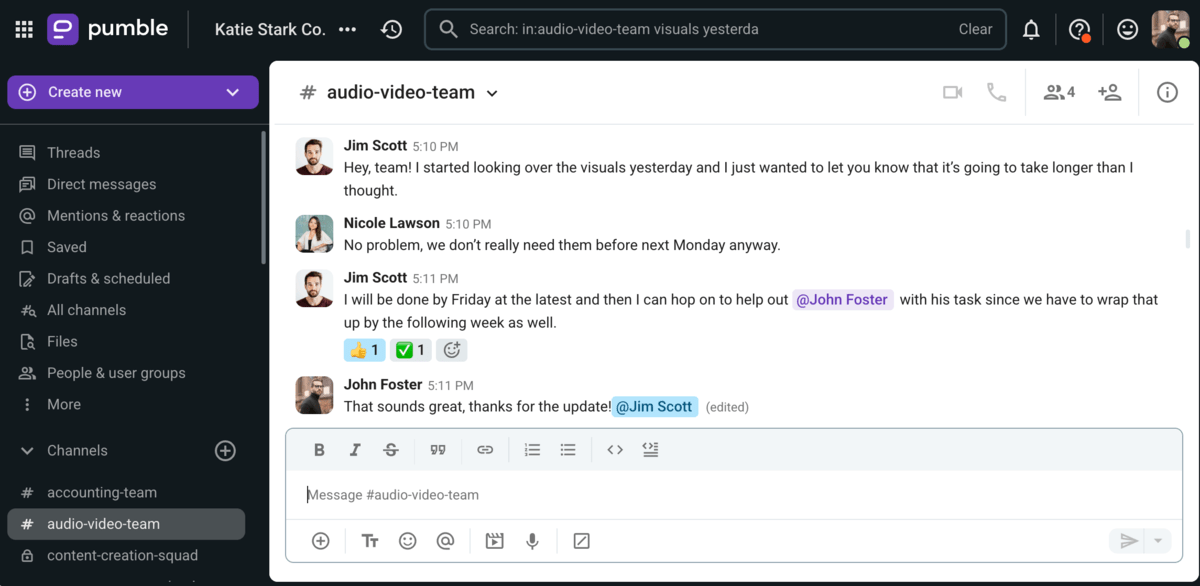
Une équipe qui collabore efficacement assure également que touts ses objectifs sont clairement définis. Ils ont des objectifs individuels et collectifs à atteindre, dont ils sont tous conscients.
Cette conscience contribue à une collaboration plus profonde, car elle permet aux personnes de s'engager plus.
Astuce n°3 : Écoutez activement et sachez reconnaître les autres
Si vous êtes un auditeur actif, vous comprendrez mieux vos collègues, leurs émotions et leurs comportements.
Si la compréhension est essentielle, il est également important que vous reconnaissiez le rôle vocalement de tous les autres membres de l'équipe. En reconnaissant ce que les autres font pour l'équipe (ou pour vous en particulier), vous établirez de meilleurs rapports avec eux et donnerez un environnement positif.
🎓 Astuce Pro de Pumble
Si vous souhaitez en savoir plus sur la manière de renforcer vos compétences en matière d'écoute active, consultez cet article :
Astuce n°4 : Apprenez à faire des compromis et à ne pas accuser les autres
Le compromis permet l'amélioration de la cohésion de l'équipe et de créer un environnement plus positif.
Cependant, même dans un environnement positif, les erreurs se produisent. Elles font partie intégrante du progrès.
Lorsqu'elles se produisent, il est important que votre équipe ne se contente pas de pointer du doigt. Les difficultés surviennent tout le temps dans les équipes. Il est important de les surmonter sans les blâmer.
Ces situations sont une occasion idéale pour :
- Analyser les protocoles de votre équipe,
- Travailler ensemble, et
- Trouver des solutions.
Gérer une telle situation n'est pas facile. L'objectif - l'amélioration de la collaboration sans blâmer les autres membres de l'équipe - est plus facile à atteindre lorsqu'on donne des critiques constructives.
Astuce n°5 : Donnez une critique constructive et appréciez le feedback
Donner et recevoir une critique ou un feedback constructif sont les deux faces d'une même pièce. En fait, ces deux aspects sont tout aussi importants pour la réussite de votre équipe.
Elles sont essentielles à une bonne communication d'équipe, qui est le principal facilitateur de la collaboration.
Les meilleurs conseils pour donner un feedback constructif sont les suivants :
- Commencez par les points positifs,
- Établissez la confiance,
- Soyez précis,
- Programmez le feedback de manière cohérente,
- Appuyez-vous sur les points positifs,
- Restez honnête,
- Donnez un feedback en personne,
- Offrez un contexte suffisant,
- Ne parlez pas AUX employés (mais AVEC les employés), et
- Donnez un feedback concret.
Il est tout aussi important de savoir recevoir des critiques constructives mais aussi d'en donner. Être réceptif aux critiques constructives et ne pas avoir peur d'admettre que vous vous trompez est essentiel pour avoir la confiance et favoriser un environnement de collaboration.
Voici un exemple de critique constructive dans Pumble.
John, le chef d'équipe, commence par souligner les points forts et les succès de Jim, un nouveau monteur vidéo. Il dirige ensuite Jim dans la bonne direction pour qu'il respecte les directives de l'équipe et de l'entreprise en matière de cohérence de la marque. Jim accepte volontiers le feedback et est reconnaissant pour les commentaires constructifs.
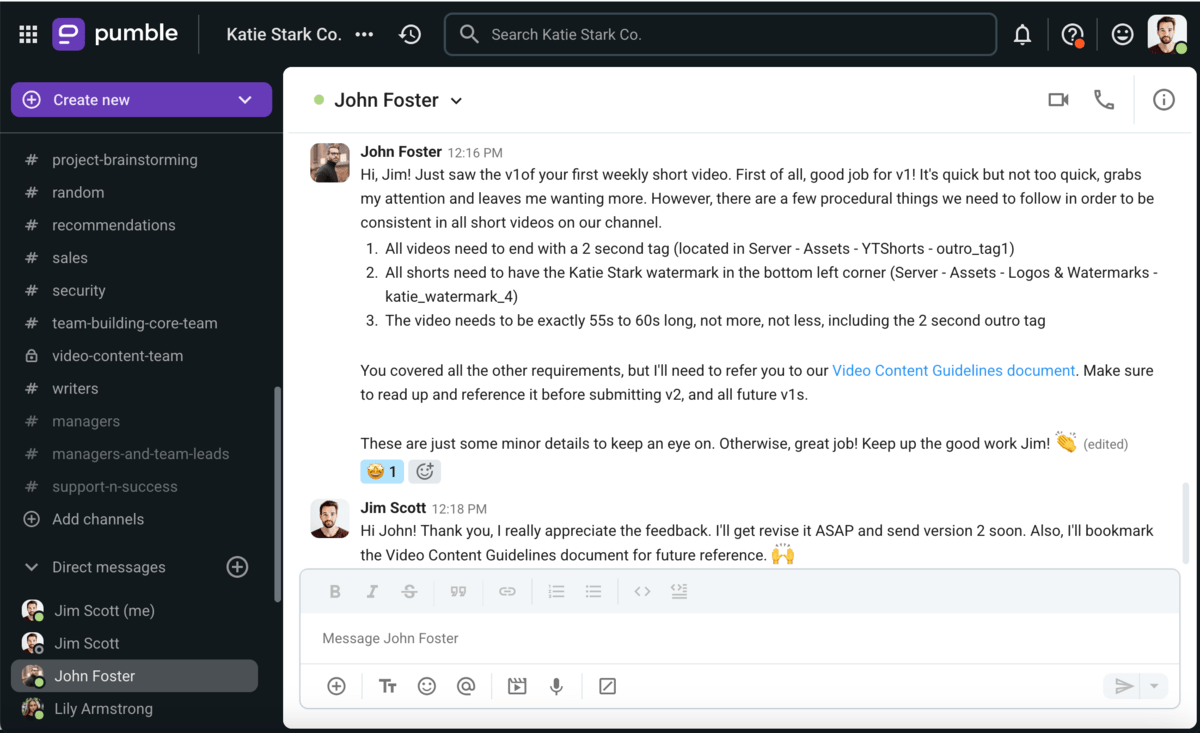
Améliorer la communication d'équipe avec Pumble
Parfois, recevoir des critiques est plus facile que d'en donner. Quand nous sommes en désaccord avec nos collègues, il est essentiel de le leur faire savoir de manière respectueuse et professionnelle.
🎓 Astuce Pro de Pumble
Si vous vous demandez quelle est la meilleure façon de demander des critiques constructives, consultez cet article :
Astuce n°6 : Évaluez les compétences de communication dans votre environnement
Enfin, assurez-vous de prêter attention aux compétences en communication — qui sont pratiquement indissociables des compétences de collaboration. Une communication efficace peut être considérée comme une condition nécessaire pour une collaboration solide dans une équipe.
Les compétences de communication généralement souhaitées dans la plupart des équipes sont les suivantes :
- Poser des questions ouvertes,
- Poser des questions fermées,
- Clarifier,
- Paraphraser,
- Utiliser des facilitateurs,
- Évaluer les signaux de communication non verbale,
- Savoir quand rester silencieux,
- Communication écrite, et
- Communication à distance.
Assurez-vous d'explorer plus avant les compétences de communication pertinentes et d'aborder le renforcement de la communication de votre équipe sous un autre angle, car différentes approches fonctionnent mieux pour différentes équipes.
🎓 Astuce Pro de Pumble
Pour examiner de plus près les compétences de communication sur le lieu de travail et comment les développer, consultez notre autre article du Pôle de connaissances :
Pourquoi les compétences dans la collaboration sont-elles importantes ?
Selon un article de HRM Online, les compétences de collaboration efficaces conduisent à des revenus plus grands, et sont les compétences les plus importantes que les employeurs recherchent chez leurs employés.
Les compétences dans la collaboration sont essentielles pour un travail d'équipe efficace, car elles :
- Renforcent la cohésion du groupe, ce qui améliore les performances globales de l'équipe
- Contribuent à une meilleure résolution des problèmes
- Aident les membres de l'équipe à apprendre des autres.
Allez voir de plus près chacune de ces raisons pour lesquelles chacun devrait s'efforcer d'améliorer ses compétences dans la collaboration.
Raison n°1 : Les compétences de collaboration améliorent les performances globales de l'équipe
Les compétences collaboratives renforcent la cohésion du groupe, ce qui permet aux membres de l'équipe de se sentir connectés :
- Les uns avec les autres,
- Aux objectifs du groupe, et
- Aux valeurs partagées.
Cela permet à l'équipe d'être plus efficace et plus productive.
Lorsque les personnes font partie d'une équipe cohésive, elles travaillent pour le compte de leur équipe plutôt que pour elles-mêmes, ce qui augmente le succès de la collaboration de l'équipe et la performance globale.
Raison n°2 : Les compétences de collaboration efficaces contribuent à une meilleure résolution des problèmes
Lorsque les gens ont de très bonnes compétences en matière de collaboration, ils peuvent aborder et résoudre les problèmes de manière coopérative et, par conséquent, plus efficace.
Les personnes qui ont un bon esprit de collaboration peuvent mieux communiquer leurs opinions, ainsi que comprendre et accepter d'autres points de vue.
Lorsque chacun apporte son point de vue à la table, les chances que votre équipe trouve des solutions adéquates augmentent.
Raison n°3 : Les bonnes compétences dans la collaboration aident les membres de l'équipe à apprendre les uns des autres
En fin de tout, la collaboration contribue au partage des connaissances et des compétences.
Les personnes avec de bonnes compétences dans la collaboration sont plus enclines à diffuser leurs connaissances et à apprendre des autres.
Améliorez vos compétences dans la collaboration avec Pumble
Quand il s'agit de la collaboration, il y a toujours place pour l'amélioration. Mais, en choisissant le bon outil de communication et de collaboration pour le travail, vous pouvez rapidement faire passer la coopération avec vos collègues à un niveau supérieur.
C'est là que Pumble entre en jeu.
Pumble est une application de communication d'équipe tout-en-un qui aide les équipes à favoriser la collaboration grâce à des fonctionnalités puissantes, telles que :
- Messagerie directe — pour les accords 1 à 1 importants,
- Canaux — pour espaces de groupe pour organiser le travail et référencer les processus pertinents pour l'ensemble de l'équipe ou de la sous-équipe,
- Fils de discussion — pour suivre facilement les conversations sur l'organisation et la délégation dans les canaux,
- Partage de fichiers — pour mettre en œuvre une communication écrite efficace avce les documents,
- Partage d'écran — pour partager facilement des informations cruciales avec votre équipe,
- Accès invité — pour inclure des collaborateurs externes dans votre communication,
- Mentions — pour attirer l'attention des membres concernés dans les grands canaux, et
- Visioconférence — pour les brainstormings, les discussions sur des sujets importants et la cohésion d'équipe.
Augmentez la productivité de votre équipe et améliorez votre collaboration.
Testez Pumble de CAKE.com dès aujourd'hui
Comment nous examinons cet article : Nos rédacteurs et éditeurs vérifient les articles et les mettent à jour lorsque de nouvelles informations sont disponibles, afin qu'ils soient toujours d'actualité.

